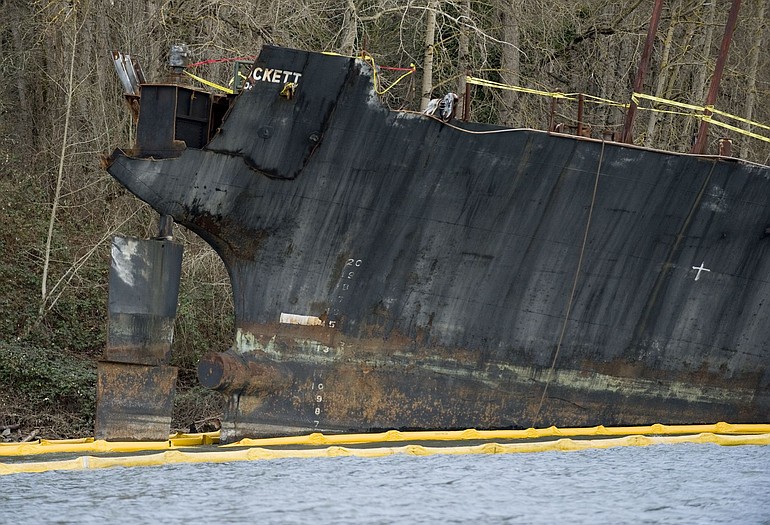Contractors are making steady progress dismantling the beached remains of the 431-foot Davy Crockett, thanks to a big infusion of federal cash.
But regulators are unsure what to do about the potential of other Davy Crocketts lurking on the lower Columbia River.
“We know there are definitely others out there,” said Lauren Goldberg, staff attorney for the environmental group Columbia Riverkeeper. “It takes a spill or some kind of catastrophic accident to really direct attention to a public health threat, which is really what I see this as.”
State authorities believe the vessel buckled and sank after owner Brett Simpson of Ellensburg attempted to scrap it while it was afloat beginning last fall.
Simpson has not returned calls from The Columbian and is no longer involved in the cleanup. U.S. Coast Guard authorities say they are conducting a criminal investigation and offered little information about their conversations with Simpson.
Spill responders from the state Department of Ecology tracked a 15-mile-long sheen of PCB-tainted oil to the Davy Crockett on Jan. 27, just three days after the Coast Guard assumed Simpson had complied with an order to remove hazardous materials onboard the vessel. The World War II-era vessel is not unlike others of that vintage, laden with polychlorinated biphenyls, asbestos and other potentially hazardous materials.
It’s now the subject of a $3.5 million cleanup, bankrolled by a federal fund created by a tax on petroleum products.
The ship’s ugly demise prompted regulators to search the Columbia for other large derelicts.
Petty Officer Eric Chandler said a Coast Guard helicopter identified about 10 large vessels on the Columbia between the ocean and Bonneville Dam.
“They did overflights to make sure there weren’t salvage operations going on,” he said. “They weren’t visibly in a state of salvage where large sections of them were removed.”
Tom Zelenka, a spokesman for Schnitzer Steel in Portland, said the value of the raw material that might be extracted from a derelict vessel pales in comparison to the cost of dismantling such a ship in a way that’s safe and protective of the environment.
“Typically, you don’t know what you’re dealing with until you open up a vessel,” Zelenka said. “That’s a very expensive proposition.”
Officials acknowledge other derelict vessels on the river could become alluring targets for scavengers.
However, state regulators and the Coast Guard have little authority to act until a ship either directly pollutes the water or becomes a hazard to navigation. State Rep. Jim Jacks, who serves on the board of the Lower Columbia River Estuary Partnership, said it makes sense to address derelict vessels before they succumb to natural elements or scavengers.
However, the Vancouver Democrat said the state doesn’t have the money to act, especially in tight economic times.
“I think it’s a problem, but it’s not very often that it’s an acute, noticeable problem that galvanizes a community to action,” Jacks said.
So regulators wait.
“We’re really limited until we get a pollution threat,” said Kim Schmanke, spokeswoman for the state Department of Ecology. “Until that time, we’re not in charge of tracking inventory or have that awareness of where derelict vessels might be.”
Erik Robinson: 360-735-4551, or erik.robinson@columbian.com.



